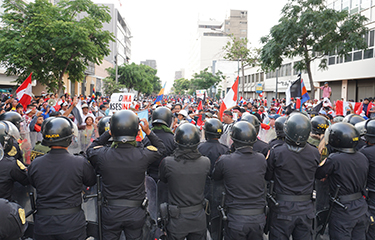The South American country of Peru boasts the largest fishery by volume in the world, catching several million metric tons (MT) of Peruvian anchoveta (Engraulis ringens) each year, according to the UN’s Food and Agriculture Organization (FAO).
Nearly all of Peru’s capture and production of anchovy is used for the production of fishmeal – a prime ingredient for animal feed, particularly for farmed fish, poultry, pork and pets. But Peru has more than just the anchoveta fishery – it boasts a coastline of 3,080 kilometers (1,910 miles) that hosts the Humboldt Current, which carries Antarctic plankton-rich waters to nourish an abundant marine food chain.
The country also has ambitions to create a domestic aquaculture industry. Neighboring Ecuador has become one of the largest producers of shrimp via aquaculture in the world, and Chile is a major salmon producer – while Peru lags behind.
Cayetana Aljovín is the president of Peru’s National Fisheries Society (SNP), which she has led since 2019. SeafoodSource was able to compile a list of the five top issues Peru is facing in 2023 based on a number of Aljovín’s op-ed pieces submitted to local paper Diario Correo, as well as comments from another fishing industry executive.
1. Ongoing violence
On 15 December 2022, Peru’s government instituted a national state of emergency, responding to outbursts of violence from protesters unhappy over the 7 December ousting of the country’s left-leaning president, Pedro Castillo, and the swearing in of then-vice president Dina Boluarte as Peru’s new head of state. Protestors saw the move as rural versus urban, poor versus rich.
Since then, protests have continued, particularly in the south of the country, and nearly 50 people have been killed, with accusations of excessive force from the police and army, The Guardian reports. Demonstrators have blocked roads and intermittently stalled several airports, heavily affecting another of Peru’s main industries, tourism.
Actors from several industries, including fishing, have called for peace.
“We understand the neglected needs of thousands of citizens and the frustration that this entails. But this, as history reminds us, cannot be solved with violence. Violence only brings more violence and destruction, truncating the dreams of thousands of families,” Aljovín said on 20 January. She advocated for dialogue, saying the violence was based on “various hidden interests that are linked to the worst mafias of illegality, corruption and outdated ideologies.”
According to the industry executive who spoke to SeafoodSource, but asked not to be named, currently there are some areas where road blockages remain active. However, the main roads and highways have been liberated with the help of the army and the people themselves, who “are looking to avoid losing everything.” For the fishery, neither shipments nor production have been interrupted for the time being.
However, the situation is ongoing and it has seafood executives, as well as international observers, on edge.
2. Anchovy fishery
Peru divides its anchovy fishing areas into two regions – south and north-central – with different capture limits and seasons set for each. The north-central is Peru’s main fishing region, with capture measuring several times that of the south region.
Peru’s Ministry of Production (PRODUCE) authorized a 28 November 2022 start for the second season of the north-central zone’s anchovy fishery, establishing a total allowable catch (TAC) of up to 2.28 million MT. However, PRODUCE stopped the season early due to the initiation of the anchovy’s spawning period, with the fishery at only 84 percent of the TAC. While PRODUCE did not provide exact figures, 84 percent of the TAC would be roughly 1.9 million MT of catch.
The early closure marked the second time in 2022 that the fishing sector didn't reach its TAC. PRODUCE also called an early end to the first season in the north-central region, which coincidentally also reached 84 percent of the TAC, or 2.34 million MT. Combined with the estimated 1.9 million MT caught in the second season, Peru's catch total was only an estimated 4.25 million MT – well below the 5.1 million MT of anchovy Peru caught in 2021.
“Despite the good health of anchovy biomass, which is around 10 million MT, 1 million MT were not caught compared to 2021 due to the late start of the second fishing season in the north-central area of the country,” Aljovín said at the end of December. She attributed the late launch to poor technical decisions at PRODUCE which she said “lost its specialist technicians and unfortunately little progress was made in fisheries policy” due to the political situation engulfing the country.
“This has had a direct impact on the production of fishmeal and fish oil for 2022 and, therefore, has affected the level of our exports,” she added. “As we pointed out at the time, for every day that fishing was stopped in this second season, Peru lost USD 30 million [EUR 28 million] per day, which will not be recovered.”
The TAC would have been met if the season had been launched just a couple of weeks previous, according to the fishing executive, who recognized 2022 as “a hard fishing year with both seasons unconcluded in terms of quotas.”
Aljovín expressed confidence that for 2023, “if weather conditions remain cool or neutral and if stability and predictability return to our sector, we will be able to return to 2021 levels, as the [Peruvian central bank] BCR predicted that the fishing sector will grow by 11.6 percent next year.”
3. Strengthening aquaculture
At the end of 2022, Peru’s congress passed bill number 31666, or the “Law for the Promotion and Strengthening of Aquaculture,” which restores tax benefits to aquaculture. It addresses law number 27360, the “Agrarian Promotion Law” which was repealed in December 2020, annulling such benefits …
Photo courtesy of Joseph Moreno M/Shutterstock








